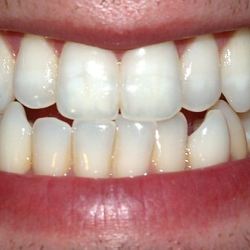Good dental hygiene is extremely important to overall health. Even simple and inexpensive interventions, such as brushing, flossing and chewing sugar-free gum, can be highly effective.

It is no secret that modern high-sugar diets have systematically harmed humans’ dental health. Around a third of the global population suffer from tooth decay, despite the availability of effective, low-cost measures to prevent it. Dentists’ warnings to brush regularly, rinse away sugary and acidic foods from our mouths, floss, and get professional cleanings are largely ignored by most Americans. For example, only about 40 percent of us floss every day.
Studies have shown repeatedly that we underestimate the risk to our health from poor dental hygiene. Tooth decay causes inflammation in surrounding gum tissue, abscesses, and eventually, tooth loss. In addition to taking a significant toll on quality of life, decay and gum disease have been linked to an increased risk of cardiovascular events, systemic infections, and complications of pregnancy.
One particularly insidious aspect of dental health is how easy it is to ignore it until it’s too late. Most chronic dental conditions follow a characteristic trajectory: a minor, irritating problem progresses to increasing degrees of pain and discomfort. The process starts when mouth bacteria, sugars, and the acids they release mix to form a colorless biological film called “plaque.” With continued consumption of sugary foods and drinks, the mouth bacteria flourish and secrete acids as waste products. As these colonies of bacteria, known as “biofilms,” grow, the body’s immune system becomes less and less able to penetrate them to eliminate the pathogenic bacteria. The plaque biofilms can harden into tartar on the enamel of the teeth, allowing them to resist routine tooth brushing.
Once these bacteria have taken hold, disease can follow. The gums (gingiva) become irritated and inflamed by the toxins and bacteria, which can lead to gum disease (periodontal disease) and tooth loss. This gum inflammation can result in bleeding when the gum tissue is ruptured. That, in turn, provides a gateway for the bacteria to contaminate the bloodstream, potentially leading to abscesses, heart valve infections, and in the worst case, sepsis — a life-threatening generalized spread of pathogenic organisms that can damage multiple organ systems.
Similarly, a condition called “pregnancy gingivitis” afflicts 50% to 70% of pregnant women, when increased pregnancy-related hormone levels cause blood vessels in the gums to become more permeable, allowing bacteria in the mouth to move to other parts of the body. Studies have shown an association between periodontitis and premature births, preeclampsia, and gestational diabetes. This is why, until the COVID lockdown, dental examinations were a routine part of medical care for many of the mothers of the roughly 10,000 babies born in the United States every day.
Moreover, while our tooth enamel is the hardest substance in our bodies, it is vulnerable to acids. The acids released by the feeding bacteria cause the enamel to demineralize and effectively break down. There is, in a manner of speaking, a “thin white line” between order and chaos in your dental health.
As calcium and phosphate ions in the enamel diffuse away, the acids can break through and reach the more vulnerable interior of the tooth, causing it to hollow out and form a cavity. This cannot be repaired naturally and requires a filling and a new, artificial sealant.
This process is, of course, not inevitable. Saliva is naturally alkaline, allowing us to neutralize acids, lower the number of bacteria in the mouth, and protect our enamel. Saliva also contains calcium and phosphate ions, remineralizing the enamel and restoring its protective capacities.
With our high-sugar diets and, therefore, a higher population of oral bacteria, our modern mouths need extra help. Fluoridated water helps teeth recover these ions, and hydroxyapatite is added to our toothpastes for the same reason. Brushing to remove excess sugars that bacteria can feed on, and flossing to remove harder-to-reach plaque which causes tartar build-up in less accessible areas also helps.
Finally, there is another intervention that is unobvious, easily available, effective, and even quite palatable: chewing gum.
The chewing gum of my Boomer childhood was packed with sugar, and therefore increased the risk of cavities by promoting the growth of mouth bacteria. But modern, sugar-free gum, sweetened with xylitol or other sugar substitutes, can have the opposite effect. In the absence of sugar, the bacteria will fail to flourish, and the act of chewing causes the mouth to produce saliva, which can neutralize acids and contains the calcium and phosphate ions needed to help the enamel remineralize. It can also substitute for a snack – if you’re chewing gum, you’re not drinking a can of Coke.
The benefits of chewing gum have been revealed by researchers for decades. A rigorous Randomized Control Trial – the gold standard of clinical testing — performed in Finland found that children who chewed xylitol-sweetened gum had 60 percent fewer cavities than the control group, and another in Belize found a reduction of 70 percent. A 2019 meta-analysis by investigators at Guy’s Dental Hospital in London of 17 dental and medical journal articles found that chewing sugar-free gum could significantly reduce tooth decay.
The use of sugar-free gum as a preventative measure for reducing the cariogenic oral bacterial load was corroborated by a more recent, 2021 systematic review and meta-analysis at King’s College London. And a 2022 multi-center cluster randomised trial based on the known link between oral health and premature birth or low birth weight demonstrated the effectiveness of chewing xylitol-sweetened gum daily during pregnancy in significantly improving pregnancy outcomes in rural Malawi.
Given the association of periodontal disease with other conditions, including chronic kidney disease; prostatitis; pulmonary function; prostate, pancreatic, and colon cancer; lower airway infections; preterm pregnancy on the one hand, and the oral health benefits of chewing sugar free gum on the other, this simple, widely available, and inexpensive remedy may be beneficial in preventing or ameliorating these complex and seemingly unrelated maladies.
As well as providing a reminder of why understanding the science behind our dental health is so important, gum also teaches us other lessons: that simpler and relatively inexpensive solutions can be highly effective when people don’t mind implementing them, and that the mundane and routine can become a critical part of preventive medicine. Now that’s something to chew on!
An earlier version of this article was published in The Mace magazine.
